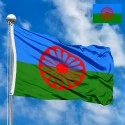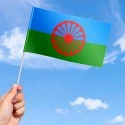Flag of the Gypsies (Romans)
- Flag Type: Ethnic
- Proportions (official): 2:3
- Population: 10,000,000 - 12,000,000 (2024, estimate)
Flag Information
Demography and Culture
- All Flags
- Flags of Countries by Continent
-
Flags of Organizations
- Flags of UN countries
- Flags of the European Union countries
- Flags of NATO countries
- Flags of the countries of the Organization of Islamic Cooperation
- Flags of the countries of the Organization of American States
- Flags of the Arab League countries
- Flags of the African Union countries
- Flags of the countries of the Union of South American Nations
- Flags of the Commonwealth of Nations
- Flags of the countries of the Secretariat of the Pacific Community
- Flags of the Nordic Council countries
- Flags of the Caribbean Community
- Flags of the countries of the Association of Southeast Asian Nations
- Flags of the East African Community
- Flags of the countries of the Organization of Turkic States
- LGBT Community Flags
- Historical Flags
- Ethnic Flags
- Flags of the USA (states)
Description
The Romani flag is a powerful and globally recognized symbol of the Romani people (also known as Roma). It is not the flag of a sovereign state but represents a transnational ethnic group with a rich history, a shared culture, and a unique identity. Adopted in 1971, this flag is a beacon of unity, resilience, and hope for a people who have faced centuries of persecution and discrimination across the world.
Design and Symbolism
The Romani flag consists of two horizontal stripes of equal width and a red wheel in the center.
-
The Blue Stripe: The top stripe is a deep sky-blue. This color represents the sky, symbolizing the boundless freedom, spirituality, and eternal home of the Romani people. It signifies the heavens and the celestial journey that mirrors their nomadic history.
-
The Green Stripe: The bottom stripe is a vibrant green. This color represents the earth and nature. It symbolizes the land and the freedom of movement across the globe, acknowledging the Romani people's connection to the natural world and their nomadic past.
-
The Red Chakra (Wheel): The central emblem is a red, sixteen-spoked wheel, known as a chakra. This is the most crucial element of the flag, holding multiple layers of meaning:
-
Indian Origin: The wheel is a direct reference to the Ashoka Chakra on the Indian national flag. It symbolizes the Romani people's ancient origins in the Indian subcontinent and serves as a powerful link to their heritage.
-
Movement and Nomadism: The wheel represents the Romani people's nomadic traditions and their constant journey throughout history.
-
Unity and Life: The red color of the wheel signifies life, energy, and blood, linking all Romani communities together. It represents the shared ancestry and the collective struggle for survival and recognition.
-
History of Creation and Adoption
The Romani flag was officially adopted at the First World Romani Congress, held in London in 1971. This congress was a landmark event that brought together representatives from various Romani groups to discuss the political, social, and cultural future of their people. The flag's design was inspired by an older, simpler flag used by Romani groups in Romania, but the chakra was added by the Congress to explicitly link the people to their Indian origins and to symbolize their unity and movement. The adoption of the flag, along with a pan-Romani anthem, "Gelem, Gelem," was a crucial step in establishing a unified international identity for a globally dispersed people.
Flag Size and Proportions
The flag typically follows standard vexillological proportions, most commonly 2:3 (height to width). The central chakra emblem is carefully sized and positioned to be a prominent feature, balancing the two main colored stripes.
The People and the Flag's Significance
The Romani people have a unique and complex history. As a non-territorial nation, they do not have a single country. Instead, they are a diverse ethnic group spread across the globe. The flag, therefore, serves as a powerful symbol of national consciousness and a rallying point for Romani people worldwide. It represents their shared identity, their rich culture, and their determination to preserve their heritage. It is a symbol of their struggle against centuries of racism, persecution, and the historical trauma of the Porajmos (the Romani Holocaust). For a people without a single homeland, the flag provides a crucial sense of belonging, unity, and pride. It is a visual testament to their existence and a hopeful symbol for their future.
Interesting Facts
-
The Romani flag's design predates its 1971 adoption, with similar two-striped flags being used earlier, but the addition of the red chakra solidified its modern, symbolic meaning.
-
The wheel's 16 spokes are a direct reference to the Ashoka Chakra, a symbol of dharma (moral law) in Indian culture, reinforcing the Romani people's historical ties to India.
-
The flag is widely used by Romani political organizations, human rights activists, and cultural groups to raise awareness about the social issues facing the community, such as discrimination, poverty, and lack of access to education.
-
The Romani anthem, "Gelem, Gelem," which was also adopted at the 1971 congress, adds another layer of international unity, providing a common voice for the people represented by the flag.
In summary, the Romani flag is a deeply meaningful and enduring symbol that beautifully encapsulates the history, values, and aspirations of a people who have journeyed across the world, holding on to their identity and culture against all odds.
In the demonstration images, full-size flags are shown with proportions of 2:3, and hand-held flags with proportions of 1:2.
Donation
Download
Completely free for commercial and non-commercial use (public domain).
You can freely use them in your news magazines, websites, software, mobile applications.
We appreciate a backlink to https://flagssite.com
Raster files - Flag of the Gypsies (Romans) (PNG, JPG)
 Waving flag
Waving flag
- PNG format (transparent background), 72dpi, dimensions in Pixels (px), aspect ratio 3:4.
- 15х20 px
- 30х40 px
- 60х80 px
- 120x160 px
- 240x320 px
 Sizes:
Sizes:
"v15" - image size (by height); if necessary, replace with available: v15, v30, v60, v120, v240.
!!! For resizing, use the Latin (eng) keyboard layout.
<img src="https://flagssite.com/flags/v15/20902.png" alt="Flag of the Gypsies (Romans)">
 Round flag
Round flag
- PNG format (transparent background), 72dpi, dimensions in Pixels (px), aspect ratio 1:1.
"d15" - image size (diameter); if necessary, replace with available: d15, d30, d60, d120, d240.
!!! For resizing, use the Latin (eng) keyboard layout.
<img src="https://flagssite.com/flags/d15/20902.png" alt="Flag of the Gypsies (Romans)">
 Rectangular flag 2:3
Rectangular flag 2:3
- JPG format, 72dpi, dimensions in Pixels (px), aspect ratio 2:3.
"h30" - image size (by height); if necessary, replace with available: h15, h30, h60, h120, h240, h360, h480.
!!! For resizing, use the Latin (eng) keyboard layout.
<img src="https://flagssite.com/flags/h30/20902.jpg" alt="Flag of the Gypsies (Romans)">









 Sizes:
Sizes:
 Sizes:
Sizes: